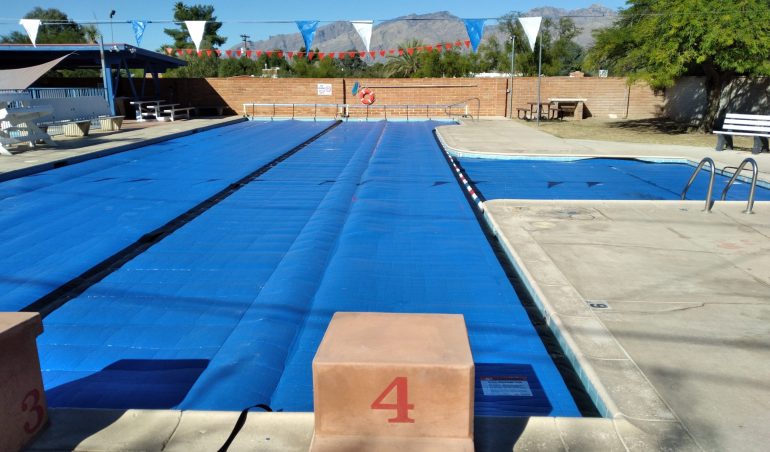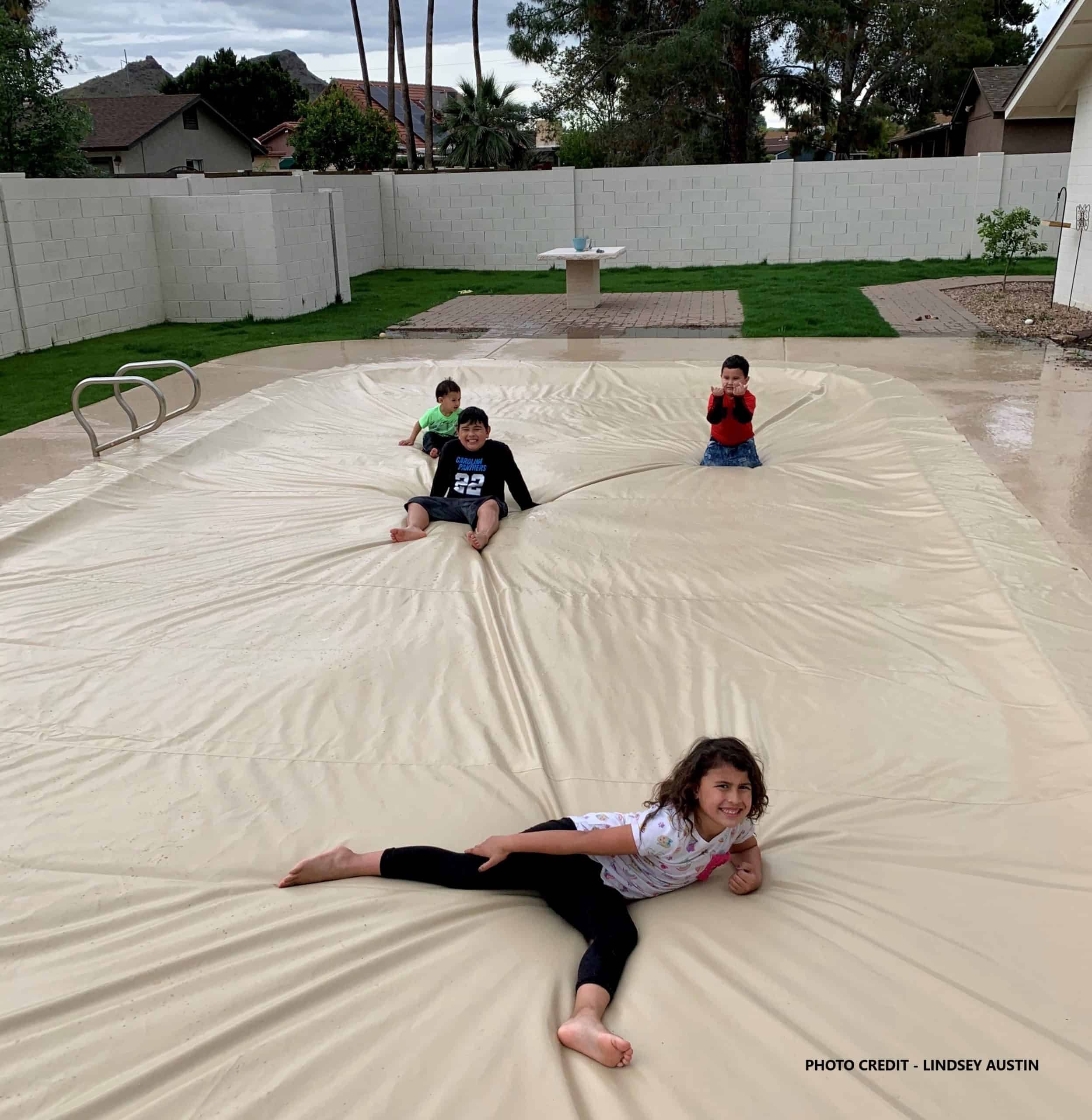Did you know that a solar cover, also known as a solar blanket, can increase the temperature of a swimming pool by an impressive 10 to 15 degrees Fahrenheit? This simple and cost-effective solution harnesses the power of the sun to heat your pool and create a more enjoyable swimming experience. With the right conditions and proper installation, a solar cover can make a significant impact on your pool’s temperature.
Key Takeaways:
- A solar cover can increase the pool water temperature by 10 to 15 degrees Fahrenheit.
- The effectiveness of the temperature increase depends on factors such as sun exposure and cover thickness.
- Solar covers are a cost-effective heating solution for pools, providing energy savings and long-term maintenance benefits.
- Proper sizing, installation, and maintenance are crucial for maximizing the performance of a solar cover.
- Pairing a solar cover with a pool heater can result in even greater warmth and energy efficiency.
Understanding Solar Pool Covers and Their Functionality
Solar pool covers by Solar Safe Pool Covers are specifically designed to harness the sun’s energy and heat swimming pools effectively. These covers are made of plastic materials such as vinyl, polyethylene, or polypropylene, which are durable and weather-resistant. The functionality of solar pool covers revolves around their unique design and materials.
The Basics of Solar Cover Technology
The design of solar pool covers includes small thermal bubbles that serve a crucial role in capturing and retaining heat. These bubbles act as miniature solar collectors, absorbing the sun’s rays and converting them into heat energy. As a result, the water temperature in the pool begins to rise. Additionally, solar covers prevent debris from entering the pool, keeping the water clean and reducing the need for maintenance.
Materials and Design: Enhancing Pool Temperature
The materials used in solar pool covers are carefully selected to enhance their functionality and efficiency. Vinyl, polyethylene, and polypropylene offer excellent insulation properties and UV resistance, making them ideal for solar covers. The thickness of the cover also plays a role in enhancing heat retention. Thicker covers can absorb and retain more heat, resulting in higher pool temperatures. Additionally, the design of solar covers maximizes the absorption of solar rays, allowing for efficient heating of the water.
How many degrees will a solar cover heat a pool?
The solar cover can increase the pool water temperature by 10 to 15 degrees Fahrenheit, on average. This temperature rise is achieved when the pool is fully covered and exposed to sunny conditions for at least three consecutive days. The actual temperature increase can vary depending on factors such as the size of the pool, cover thickness, and weather conditions.
It is important to note that the solar cover’s main function is to retain and enhance the pool temperature, rather than providing instant heating.
Temperature Gains: Solar Cover Pool Heat Retention Explained
Solar pool covers play a crucial role in retaining and increasing the pool temperature by preventing heat loss through evaporation. These covers help trap the heat generated by the sun, allowing the pool to maintain a higher temperature and reducing the need for additional heating methods.
Average Temperature Increase with Solar Covers
On average, a fully covered pool can experience a temperature increase of 10 to 15 degrees Fahrenheit. The solar cover acts as a barrier, preventing heat from escaping and maximizing the pool’s heat retention capabilities. The actual temperature gains may vary depending on factors such as the thickness of the cover, sun exposure, and wind conditions. Thicker covers tend to provide better insulation and heat retention, resulting in higher temperature gains.
The Impact of Weather Conditions on Pool Heating
Weather conditions, such as cloud coverage and wind, can significantly affect the effectiveness of solar cover heat retention. Cloudy days limit the amount of direct sunlight reaching the pool, reducing the heat absorbed by the cover. Similarly, strong winds can increase the rate of heat loss through evaporation, counteracting the efforts of the solar cover. However, despite these factors, solar covers still offer significant benefits in terms of heat retention and pool temperature elevation.
The image above illustrates the positive impact of a solar cover on temperature gains. By using a solar cover, pool owners can enjoy warmer water temperatures and extend their swimming season.
Pairing Solar Covers with Pool Heaters for Maximum Warmth
Solar covers provide an effective way to heat a swimming pool, but when paired with pool heaters, they can achieve maximum warmth and enhance the overall heating process. The combination of solar covers and pool heaters offers several benefits, including increased pool temperature, reduced energy consumption, and cost-effective pool heating. The solar cover acts as a barrier to prevent heat loss and retain the warmth generated by the heater, resulting in greater energy efficiency and longer-lasting warmth.
Benefits of Using Solar Covers with Heaters
By combining solar covers with pool heaters, pool owners can enjoy the following benefits:
- Increased Pool Temperature: The integration of solar covers with heaters significantly raises the pool water temperature. The covers capture and retain the sun’s heat, while the pool heater provides an additional source of warmth, resulting in a comfortable swimming environment.
- Reduced Energy Consumption: Solar covers help to dramatically decrease the energy consumption of pool heaters. By utilizing the heat trapped by the cover, pool heaters have to work less to achieve and maintain the desired temperature, resulting in lower energy costs.
- Cost-Effective Heating Combination: Pairing solar covers with pool heaters offers a cost-effective solution for pool heating. Solar covers are relatively inexpensive compared to traditional pool heaters, and their integration with heaters maximizes their effectiveness, ensuring an efficient and economical heating process.
With the combination of solar covers and pool heaters, pool owners can enjoy the benefits of increased pool temperature, reduced energy consumption, and cost-effective heating. The synergy between solar covers and heaters creates an optimal heating solution for those seeking warmth and comfort in their swimming pools.
Preventing Heat Loss: The Cost-Effective Combination
Solar covers play a vital role in preventing heat loss in swimming pools, especially when paired with pool heaters. The cover acts as a protective barrier, minimizing heat evaporation and reducing the energy required to maintain the desired pool temperature. When used in combination, solar covers and pool heaters provide a cost-effective heating solution with the following advantages:
- Heat Retention: Solar covers effectively trap heat within the pool, preventing its dissipation into the surrounding environment. This reduces the pool heater’s workload and translates to cost savings in terms of energy consumption.
- Extended Heating Period: The combination of solar covers and pool heaters allows for an extended swimming season. By minimizing heat loss, the pool can retain warmth for longer periods, enabling pool owners to enjoy the benefits of their pool even during colder months.
- Enhanced Energy Efficiency: The integration of solar covers with pool heaters optimizes the overall energy efficiency of the heating system. By utilizing the heat captured by the cover, the pool heater can operate at a lower intensity, resulting in reduced energy usage and lower utility bills.
By combining solar covers with pool heaters, pool owners can prevent heat loss, extend the swimming season, and achieve cost-effective pool heating. The synergy between these two heating components ensures maximum warmth and energy efficiency, offering an ideal heating solution for pool enthusiasts.
Proper Sizing and Installation of Solar Covers
Proper sizing and installation are key factors in ensuring the optimal performance of solar covers for your swimming pool. It is essential to choose a cover that is the right size for your pool to ensure proper coverage and effectiveness.
When selecting a solar cover, it is important to consider the dimensions of your pool. Measure your pool carefully and choose a cover that matches or slightly exceeds the dimensions to ensure that it can fully cover the surface of the water.
During installation, place the solar cover on the water’s surface and carefully smooth it out to eliminate any wrinkles or air pockets. This will ensure maximum heat retention and prevent debris from entering the pool.
To prevent your solar cover from blowing off or moving with water circulation, it is crucial to securely anchor the cover. You can use pool cover clips or straps to secure the cover in place, ensuring it stays in position even during strong winds or heavy rainfall.
Proper sizing and installation of solar covers will not only maximize their effectiveness in heating your pool but also prolong their lifespan. By following these steps, you can enjoy the benefits of a properly heated pool and reduce energy consumption.
Maintenance Challenges: Algae Growth and Solar Cover Care
While solar covers offer numerous advantages, they can present maintenance challenges, including the growth of algae.
Preventing Algae with Appropriate Solar Cover Use
To prevent algae growth, it is important to maintain proper water chemistry, circulation, and pool cleanliness. Algae thrive in environments with imbalanced pH levels and inadequate circulation. Regularly testing and adjusting the pool water chemistry will help create an unfavorable environment for algae to grow. Implementing proper water circulation through pumps, filters, and regular maintenance will also inhibit algae growth. Removing the solar cover regularly and ensuring it is thoroughly cleaned and dried before placing it back on the pool will further reduce the risk of algae by preventing organic matter from accumulating on the cover.
Enhanced Pool Cleanliness: Dirt and Debris Repellence
Solar covers not only help retain heat but also enhance pool cleanliness by preventing dirt and debris from entering the water. The cover acts as a barrier, effectively blocking leaves, twigs, and other particles from falling into the pool. This reduces the need for frequent cleaning and minimizes the strain on the pool’s filtration system. Regularly removing and cleaning the cover will ensure its optimal performance in repelling dirt and debris.
Solar Pool Covers: An Economical Heating Solution
Solar pool covers offer an economical heating solution compared to traditional pool heaters. While the initial cost of solar covers may be lower than heaters, it is important to consider long-term savings.
Comparing Costs: Solar Pool Covers vs. Traditional Pool Heaters
When it comes to cost, solar pool covers have a distinct advantage over traditional pool heaters. The initial investment in a solar cover is typically lower than purchasing and installing a pool heater. This makes solar covers a more budget-friendly option, especially for pool owners looking for a cost-effective heating solution.
In addition to lower upfront costs, the operational expenses of solar covers are significantly lower compared to pool heaters. Solar covers utilize the sun’s energy, which is free and abundant, to heat the pool. This means that solar covers require minimal energy input, resulting in reduced energy consumption and lower utility bills.
On the other hand, traditional pool heaters rely on gas or electricity, which can be costly to operate, especially over an extended period. The ongoing expenses associated with pool heaters can quickly add up, making them less economical in the long run.
Furthermore, solar pool covers offer a more sustainable heating option, as they harness renewable energy from the sun, reducing carbon emissions and minimizing the pool’s environmental impact.
Long-Term Savings: Energy and Maintenance Considerations
In addition to cost savings, solar pool covers provide long-term financial benefits through energy and maintenance savings. As mentioned earlier, solar covers require minimal energy input, relying on the sun’s rays to heat the pool. This not only reduces energy consumption but also helps conserve natural resources.
Moreover, solar covers help in heat retention by preventing heat loss through evaporation. By covering the pool surface, they create a barrier that traps the heat generated by sunlight and the pool heater, reducing the need for excessive reheating. This results in energy savings, as the pool requires less heating to maintain the desired temperature.
Additionally, the maintenance requirements of solar covers are relatively low compared to traditional pool heaters. Solar covers are designed to prevent debris from entering the pool, which reduces the need for frequent cleaning and maintenance of the filtration system. With fewer maintenance demands, pool owners save both time and money in the long run.
Conclusion
In conclusion, solar pool covers are an effective and cost-effective solution for heating a swimming pool. By harnessing the sun’s energy, these covers can increase the pool water temperature by an average of 10 to 15 degrees Fahrenheit. While the temperature gains may vary depending on factors such as cover thickness and sun exposure, solar covers excel at heat retention and enhancing pool heating.
Solar covers can be used alone, but they can also be paired with pool heaters for maximum warmth. This combination offers benefits such as increased pool temperature, reduced energy consumption, and cost-effective pool heating. The solar cover acts as a barrier, preventing heat loss and resulting in greater energy efficiency and longer-lasting warmth.
Proper sizing, installation, and maintenance are crucial for the optimal performance of solar pool covers. It is important to choose a cover that fits the dimensions of the pool and ensure it is securely anchored. Regularly removing the cover and maintaining good water quality help prevent algae growth and keep the pool clean. By considering long-term savings, solar covers prove to be an economical heating solution compared to traditional pool heaters, as they require minimal energy input and maintenance.
Call our experts at Solar Safe Pool Covers to learn more about how our Solar Pool covers and heat your pool. We are based in Phoenix, AZ but service the Tucson, AZ area as well.
FAQ
How many degrees will a solar cover heat a pool?
On average, a fully covered swimming pool can increase the water temperature by 10 to 15 degrees Fahrenheit.
What is a solar pool cover and how does it work?
A solar cover, also known as a solar blanket, is a plastic cover that floats on the surface of the water and harnesses the UV rays from the sun to heat the pool. It is designed to retain and enhance the pool temperature by preventing heat loss through evaporation.
What materials are solar covers made of?
Solar covers are made of plastic materials such as vinyl, polyethylene, or polypropylene. They are designed with small thermal bubbles that capture and retain heat while preventing debris from entering the pool.
How long does it take for a solar cover to heat a pool?
Solar covers can heat a pool in as little as 6 hours, especially when paired with a pool heater. The actual time may vary depending on factors such as sun exposure, cover thickness, and the use of a pool heater.
How effective are solar covers in retaining pool heat?
On average, a fully covered pool can experience a temperature increase of 10 to 15 degrees Fahrenheit. However, the actual temperature gains may vary depending on factors such as cover thickness, sun exposure, and wind conditions.
Can solar covers be used with pool heaters?
Yes, solar covers can be used in conjunction with pool heaters to achieve maximum warmth. The combination of solar covers and heaters offers benefits such as increased pool temperature, reduced energy consumption, and cost-effective pool heating.
How should a solar cover be sized and installed?
When selecting a solar cover, it is important to choose a size that fits the dimensions of the pool. It is recommended to select a cover that is slightly larger than the pool to ensure proper coverage. Installation involves placing the cover on the water’s surface and smoothing it out to eliminate wrinkles and air pockets. The cover should be securely anchored to prevent it from blowing off or moving with water circulation.
Do solar covers require any maintenance?
Yes, solar covers can present maintenance challenges, including the growth of algae. To prevent algae growth, it is important to maintain proper water chemistry, circulation, and pool cleanliness. Regularly removing the cover and maintaining good water quality will minimize the risk of algae. Additionally, solar covers help enhance pool cleanliness by preventing dirt and debris from entering the water, reducing the need for frequent cleaning and filtration system maintenance.
Are solar covers a cost-effective heating solution?
Yes, solar covers offer long-term savings compared to traditional pool heaters. While the initial cost of solar covers may be lower than heaters, they require minimal energy input and maintenance, resulting in reduced energy consumption and lower maintenance costs over time.






